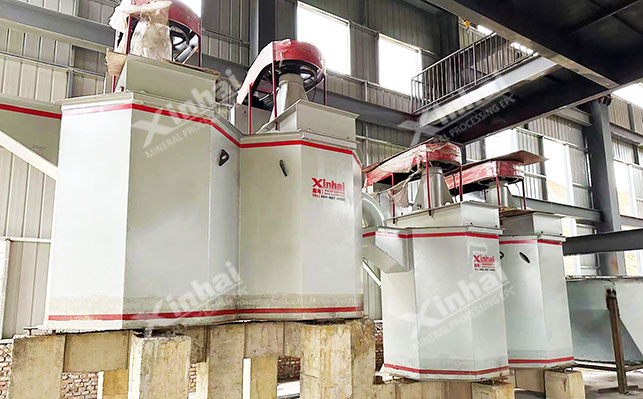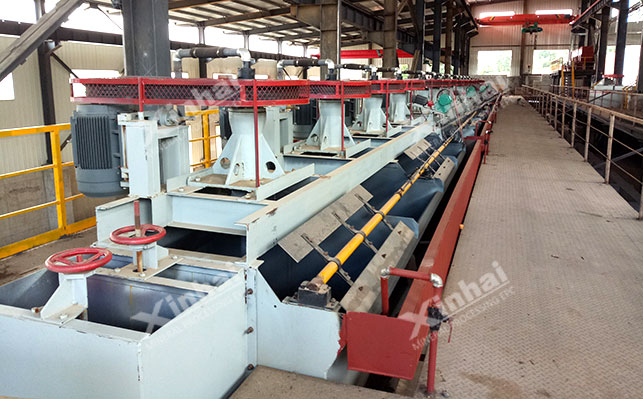
15311826613
Click to add WeChatGlobal high-quality phosphate resources are continuously developed and utilized, and their reserves are declining year by year, especially in areas with low ore grades. The proportion of medium and low-grade phosphate resources is increasing. In the face of such changes in the proportion of resources, studying how to mine and utilize medium and low-grade phosphate is the main solution. Phosphate ore dressing technology is the key to improving the utilization efficiency of mineral resources, which directly affects the recovery rate, grade and environment of phosphate resources. This article will introduce phosphate ore dressing technology.
At present, the common phosphate ore dressing technologies in ore dressing plants are mainly scrubbing and desludging technology, flotation technology and chemical ore dressing technology.

The scrubbing and desludging technology of phosphorus mainly uses physical friction and water flow to remove fine mud and impurities on the surface of phosphate ore to improve the purity of phosphate ore. Its process mainly includes crushing, screening, scrubbing, desludging and other links. First, the phosphate rock is crushed to make its particle size meet the requirements of subsequent processing; then, particles of different particle sizes are separated by screening; then, in the scrubbing equipment, mechanical stirring and other methods are used to make the ore particles rub against each other and the inner wall of the scrubbing equipment, and at the same time, water flow is used to flush the fine mud attached to the surface of the phosphate rock to peel off; finally, the fine mud is separated from the phosphate rock by graded desludging.
The scope of application of this method is limited, and it is not suitable for processing ores with high concentrate enrichment ratios. The concentrate grade obtained by this process is relatively low, which is difficult to meet the industrial production with high demand for high-grade phosphate rock. At the same time, the high content of phosphate minerals in tailings means that resource recovery is insufficient, resulting in a certain degree of resource waste.
Flotation is a common technology for phosphate ore beneficiation. It uses beneficiation agents to adjust the hydrophilicity and lipophilicity of the mineral surface. When the surface properties of the mineral change, the contact with the foam will also change, thereby achieving the separation of different minerals. Specifically, during the flotation process, specific collectors, frothers and other agents are added to the pulp. The collectors will selectively adsorb on the surface of the phosphate minerals, making the surface hydrophobic and able to combine with bubbles; the frothers promote the generation of a large number of stable bubbles in the pulp. When the bubbles rise, the bubbles adsorbed with phosphate minerals will float to the surface of the pulp to form a foam layer. The foam layer can be scraped to obtain the concentrate containing phosphate minerals, while the impurities such as gangue minerals remain in the pulp.

The flotation process can be used to treat phosphate ores with complex mineral structures, and is an important means to improve the recovery rate and grade of phosphate ore. Common phosphate ore flotation is mainly divided into the following types:
Positive flotation process: mostly used to treat siliceous phosphate ores with more silicon minerals and low magnesium oxide content. By adding inhibitors to inhibit gangue minerals such as quartz and feldspar, phosphate minerals can combine with bubbles and float out first, realizing the separation of phosphate minerals and gangue minerals.
Reverse flotation process: suitable for treating calcareous phosphate rocks containing minerals such as dolomite and gypsum. This process is to suppress the flotation of phosphate minerals and allow the gangue minerals to float out first, thereby improving the grade of phosphate ore.
Direct and reverse flotation process: mainly for complex phosphate ore, first float out phosphate minerals first, and then float out gangue minerals. This process can separate different types of minerals in multiple stages, and can effectively process phosphate ore with complex mineral composition and multiple impurities.
Reverse flotation process: contrary to direct and reverse flotation, it has good adaptability to phosphate ore containing more gangue minerals. By first floating gangue minerals and then processing phosphate minerals, the flotation sequence can be flexibly adjusted according to the characteristics of the ore to improve the efficiency of mineral processing.
Double reverse flotation process: adopts two-step reverse flotation, first removes gangue minerals, and then removes other impurity minerals. It is particularly suitable for processing low-grade phosphate ore, which can effectively improve the grade and recovery rate of phosphate ore, and can solve the problem of difficulty in utilizing low-grade phosphate ore to a certain extent.
Stage grinding and stage beneficiation: used to process phosphate ore with poor dissociation degree. Through stage grinding, the phosphate ore is gradually ground to a suitable particle size, so that the phosphate minerals and the gangue minerals are fully dissociated, and then the beneficiation is carried out at different stages to improve the efficiency of phosphate ore separation and avoid the adverse effects of over-grinding or under-grinding on the beneficiation indicators.
Chemical phosphorus selection mainly achieves the separation of phosphate ore and gangue minerals through chemical reactions, which may include partial acidification, thermal decomposition and activation-promoted release.
Partial acidification method: Use acidic solution to partially acidify the phosphate ore to dissolve or transform the gangue minerals, thereby achieving the separation of phosphate ore and gangue minerals.
Thermal decomposition method: Use high temperature to decompose the gangue minerals in the ore to generate easily separable meltable products. Under high temperature environment, the chemical composition and structure of the gangue minerals change and are converted into substances that can be separated by physical methods, such as molten or gaseous substances, to achieve separation from the phosphate ore.
Activation-promoted release method: According to the activation-promoted reaction of phosphate minerals and gangue minerals, their dissolution rate is increased to achieve the separation of the two. By adding specific activators, the activity of the mineral surface is changed, making phosphate minerals or gangue minerals more soluble or reactive under specific conditions, thereby achieving separation effects.
Phosphate ore dressing technology is of great significance for the utilization of phosphate resources. With the increase of medium and low-grade phosphate resources, the use of efficient, green and environmentally friendly dressing technology is an important way to improve the utilization rate of phosphate resources. Xinhai Mining will adhere to customized phosphate ore dressing services throughout the entire industry chain to meet the special needs of each phosphate ore dressing plant, help customers build efficient, intelligent and green phosphate ore dressing plants, and achieve high-quality development of the phosphate industry.